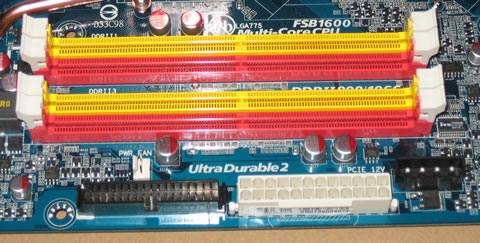Intel X38 Motherboard Roundup
6. The Package
Review Pages
2. Asus Maximus Formula
3. The Package
4. BIOS
5. Gigabyte GA-X38-DQ6
6. The Package
7. BIOS
8. Test Configuration
9. Everest Ultimate Edition 2007
10. SiSOFT Sandra
11. PCMARK - 3DMARK
12. Science Mark - PovRay - x264 Benchmark
13. Maxon Cinebench
14. SuperPi
15. SYSmark 2007 - WorldBench
16. Lost Planet: Extreme Condition
17. Overclocking
18. Conclusion
The Gigabyte P35-DQ6 costs around €240~250, as found at several online stores. The retail package is full of logos, showing off the motherboard features:

All retail contents are show below:
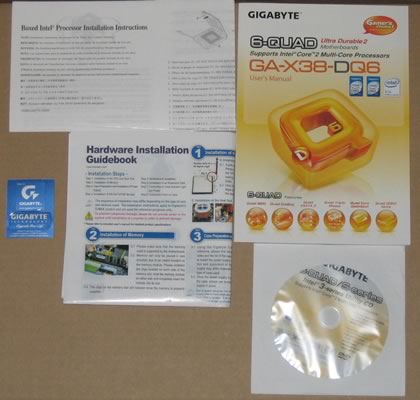
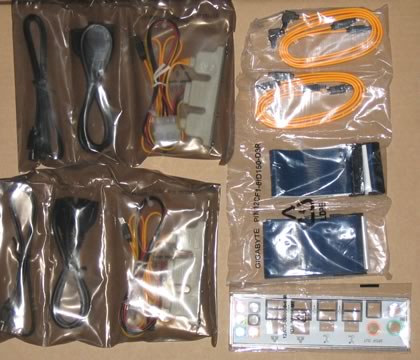
Below is a list of what's included in the retail package:
- 4x Serial ATA cables
- 4x eSata (on two rear brackets)
- 4x USB (on two rear brackets).
- I/O Shield
- User's manual
- 2x Molex-Sata power cables
- 1x Floppy & 1x IDE ribbons
- 1x CD-ROM with drivers
- Multi-Language quick install guide
- Printed manual in English
The board is protected in a plastic shell that keeps it safe from transportation "hazards".

The Gigabyte GA-X38-DQ6 has much lower profile copper heatpipes than we saw with the GA-P35-DQ6. That's a good sign, since many users had complaints with the GA-P35-DQ6 design. We can see that there are three major copper heatsinks that are connected via pipelines to distribute heat from the north/southbridge and voltage chips:
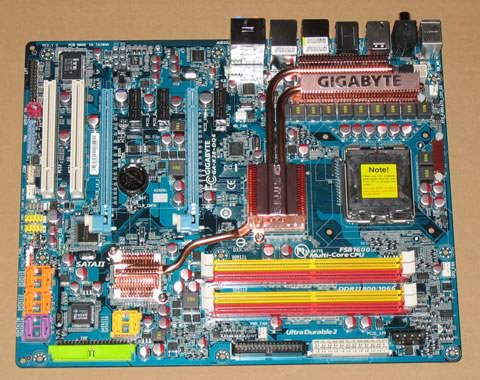
Zooming in on the CPU area, there is plenty of free space for larger, 3rd party coolers.
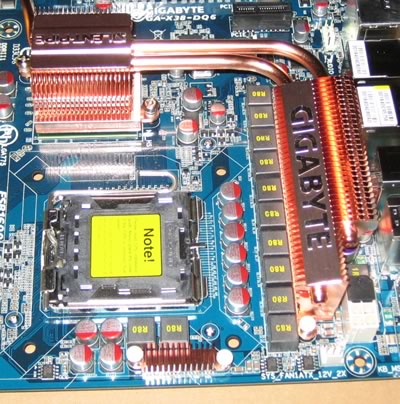
For your reference, here is a picture with the Intel stock cooler installed. There is some distance from the northbridge heatsink, but probably not as much as we would like. Around the motherboard, there are five (5) fan connections available for additional coolers:

Flipping the board over, we can see various copper plates on the back, which further help lower the overall system temperature:

The motherboard has four memory banks for DDR2 memory modules:
Moving to the southbridge area on the board, we can see the passive heatsink and the 10x SATA2 connections, well organized and easily accessible. Note how many different colours are used to separate each component on the board. While it looks a little strange at first, it is useful for identifying very quickly, where the different connections are. The SATA 2 ports are placed conveniently so as to avoid any big, full size graphics cards, like the Nvidia 8800GTX.
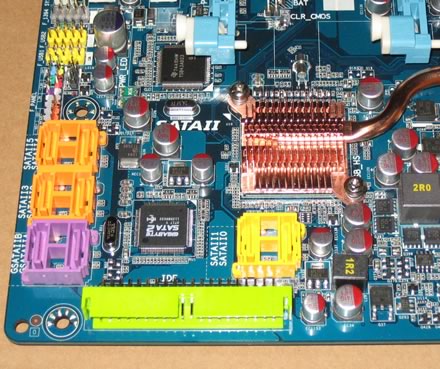
The motherboard supports the CrossFire Technology according to the specs. Thanks to the Intel X38, there are 2x PCI-E x16 slots when installing two cards in the blue slots. There is enough space between them to accommodate the big VGA cards:

There are several extra connections for USB, Front Panel Audio, COM2 and Firewire. Several port modules are available in the retail package. The back I/O panel has the usual connections:
- 1 x PS/2 keyboard port
- 1 x PS/2 mouse port
- 1 x coaxial S/PDIF Out connector
- 1 x optical S/PDIF Out connector
- 8 x USB 2.0/1.1 ports
- 2 x IEEE 1394a ports
- 2 x RJ-45 port
- 6 x audio jacks (Center/Subwoofer Speaker Out/Rear Speaker Out/Side Speaker Out/Line In/Line Out/Microphone)
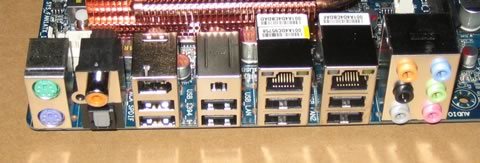
Gigabyte has kept both PS/2 Mouse+Keyboard connections, compared to Asus who has removed the PS/2 mouse support in favor of an extra two USB ports. It's interesting to take a look at the rear panel with all port modules installed. There are two modules for eSATA with connections to external power supply.
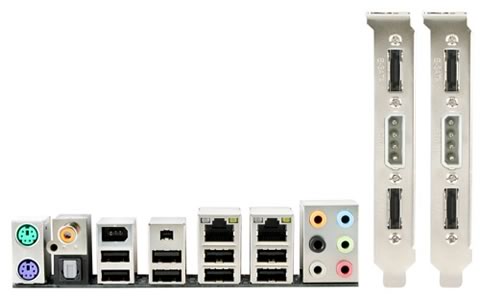
Review Pages
2. Asus Maximus Formula
3. The Package
4. BIOS
5. Gigabyte GA-X38-DQ6
6. The Package
7. BIOS
8. Test Configuration
9. Everest Ultimate Edition 2007
10. SiSOFT Sandra
11. PCMARK - 3DMARK
12. Science Mark - PovRay - x264 Benchmark
13. Maxon Cinebench
14. SuperPi
15. SYSmark 2007 - WorldBench
16. Lost Planet: Extreme Condition
17. Overclocking
18. Conclusion

